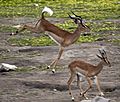Stotting facts for kids
Stotting (also called pronking) is a special way some animals, like gazelles, jump. When they stot, they spring into the air, lifting all four feet off the ground at the same time. Their legs usually stay stiff, and their back might arch with their head pointing down.
Scientists have many ideas about why animals stot. One main idea is that it's an honest signal to predators. It tells the predator that the stotting animal is very fit and healthy, so it's probably not worth chasing.


Why Do Animals Stot?
Stotting uses up energy and makes an animal more visible to a predator. So, it must be helpful in some way! Here are some ideas about why animals stot:
- Not for quick escape: Some people thought stotting helps animals escape quickly or jump over things. But this isn't true for Thomson's gazelles. They don't stot if a predator is very close (less than 40 meters away).
- Spotting hidden dangers: Animals in tall grass might jump high to look around for hidden predators. This is like a quick peek to make sure no one is hiding.
- Warning others: Stotting could be an alarm signal to other animals in the herd. It tells them that a predator is nearby, which helps everyone stay safe.
- Confusing predators: When many animals stot at once, it might make it harder for a predator to pick out just one animal to chase. It's similar to how zebra stripes might confuse predators when they run.
- Showing off fitness: Stotting can be an honest way for an animal to show how strong and healthy it is. By doing something that seems risky, the animal tells the predator, "I'm too fast for you!" This helps the prey animal avoid being chased, and the predator doesn't waste time chasing an animal it won't catch.
- "I see you!": An animal might stot to let a predator know it has been seen. If the predator knows it's been spotted, it loses the element of surprise. This can make the predator give up the hunt. For example, cheetahs often stop hunting when gazelles stot. However, gazelles stot less to African wild dogs, which chase prey for a long time and don't rely on surprise.
- Attracting mates: Some scientists think stotting might be a way for animals to show off their fitness to potential mates. This is part of sexual selection, where animals choose partners based on certain traits.
- Just for fun: Young animals sometimes stot as a form of play. This play might help them practice skills they will need when they are older. However, adult animals usually stot when they are responding to predators.
The scientist John Maynard Smith thought that stotting is a clear sign of an animal's health and how well it can escape. He believed it's a signal especially for predators that chase their prey.
Images for kids
-
Adult male black-faced impala stotting
See also
 In Spanish: Salto de rebote para niños
In Spanish: Salto de rebote para niños



